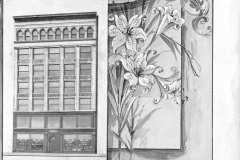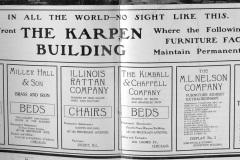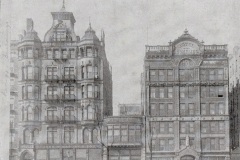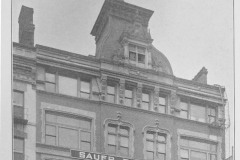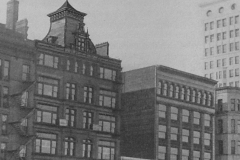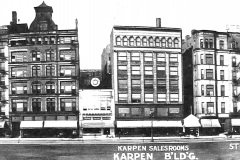More Real Estate on Michigan Avenue: 1900-1910
Michigan Avenue property destined to boom…. The lake front’s sun is rising fast and soon will be on high, according to real estate men…. Chicago Daily Tribune, August 30, 1903.
S. Karpen & Bros. bought the Richelieu Hotel at 187-188 Michigan Avenue in 1899 and closed on it on December 31, 1903. The completely renovated building was its sales headquarters and showroom until 1911. There Karpen brothers Adolph and Julius led marketing and sales, and Mike, William, and Leo spent time when they were not on the road as salesmen. (Brothers Solomon, Oscar, and Isaac had their offices in the factory).
The Karpen Building added to the growing prestige of the company. Its furniture trade journal advertisements featured and even magnified The Karpen Building, claiming “In all the world, No sight like this; the Lake Front of Chicago, showing The Karpen Building.” [1]
At the end of 1903, Karpen Bros. bought the ground lease for another well-known building that adjoined its showroom on Michigan Avenue. The “Masury Building” was constructed 1881 by John W. Masury & Son manufacturers of paints and varnishes. The Masury Building, 189-192 Michigan Boulevard (after 1909, number 324-332 S. Michigan Avenue), had a frontage of 82 feet on Michigan Avenue (a six-story main building and a two-story annex).
Karpen Bros. bought the property from the estate of John Masury for $450,000 of which $150,000 was paid in cash. Karpen Bros. secured the remaining $300,000 by a five-year mortgage at 4% interest.[2] While the brothers remodeled the exterior and interior of the 187-188 building, they did not alter the exterior of this building. They leased some showroom space to other companies.[3]
In 1905 Karpen Bros. bought a five-story building at 258-260 Wabash Avenue across an alley from its other two buildings to increase its showroom space by about 7,000 square feet. The building was purchased for $245,000, and was sold for $350,000 three years later. [4]
The company was thus a major player on Michigan Boulevard with 135 feet of frontage. [5] It marked “the rapid growth of the furniture manufacturing business of Chicago.”[6] It occupied 115,004 square feet in its Main Building (72, 540 square feet over 8 floors) and in its Annex [the Masury Building] (42,500 square feet over five floors).[7]
- Grand Rapids Furniture Record, June 1902, 138. Furniture Worker, June 10, 1902, 48. ↑
- Chicago Daily Tribune, Dec. 31, 1903. ↑
- Furniture Trade Review, June 10, 1903, 80. ↑
- Chicago Daily Tribune, Feb. 28, 1907; Mar. 3, 1907; Mar. 6, 1907. ↑
- Chicago Daily Tribune, Nov. 26, 1902; Nov. 30, 1902. Furniture Trade Review, Aug. 10, 1905, 66. ↑
- Furniture Trade Review, Aug. 10, 1905, 66. ↑
- Furniture Journal, Oct. 9, 1908, 14c ; Xmas 1908, 213. ↑

